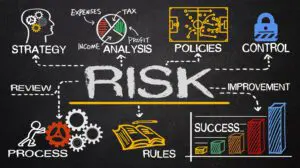
Failure is getting considerable attention in leadership and management circles these days. Articles, books, and keynote speeches preach the value of mistakes and learning from failure. The current dialogue begins once the mistake or failure occurs and addresses how to leverage it for maximum return. But the employee must take a risk before any of this is possible.
Risk is defined as a ‘situation that involves exposure to danger.’ And in today’s workplace, the dangers are very real. Between the rise of AI, the return to work mandates, and the shift in power dynamics employees are insecure. It’s been an employee’s job market since the pandemic. But this is shifting in response to the rapid rise in inflation and the resulting economic uncertainty. And with many businesses still trying to recover from the after math of the global shutdowns, and pressure to deliver quarterly results to Wall Street frequently overshadows a longer-term focus.
And we wonder why so many employees are risk-averse!
But, with Growth and Innovation playing central roles in the strategic plans of most organizations, leaders must begin to consciously implement strategies designed to encourage and build a culture of risk-taking. And they can do it with approaches that range from bold to basic.
Several years ago, The Wall Street Journal printed an article by Leslie Know about Jim Donald’s bold approach to encouraging risk-taking. When he took over Extended Stay America, the hotel chain was emerging from bankruptcy and employees were immobilized by concern over losing their jobs. His response was to give “everyone a safety net: He created a batch of miniature ‘Get Out of Jail, Free’ cards, and is gradually handing them out to his 9,000 employees. All they had to do, he told them, was call in the card when they took a big risk on behalf of the company — no questions asked.”
Bold steps like this send an unambiguous message to employees and provide the impetus for individual behaviors and organizational cultures to change. But the stuff of legends and WSJ-worthy acts aren’t the only way to encourage risk-taking.
The ability to take intelligent risks can be cultivated just like other desirable employee behaviors using some less bold and, what some might consider, more basic change strategies. Consider the following:
Leading by example is recognized as one of the most powerful approaches to affecting change. When employees see their own managers trying new things, stepping out of their comfort zones, and taking risks in service of the business, it sends a strong message about what is valued. When leaders are transparent about the outcomes of these acts – both good and bad – it begins to create the conditions for others to do the same.
Employees need knowledge and tools to be able to build their risk tolerance and capacity. They need to understand the big picture, where the organization is going, and their role in getting there. They need to have some level of business acumen and a sense of the business landscape and factors impinging upon it. This information is the context required to consider, calibrate, and ultimately seize risks that are likely to drive results.
New behaviors take hold when they are appropriate, supported, and encouraged. Risk-taking is no different. Systematically allowing employees to debate and explore different approaches in a safe environment, jointly vet potentially risky propositions, and partner with others creates the safety net many need to venture into this new territory.
Ron Ashkenas’ article, “The Risk-Taker’s Dilemma,” begins by recapping the classic research in which lab mice became highly stressed and confused when the consequences for behavior were random or contradictory. He goes on to explain:
“I was reminded of this dynamic earlier this year when I interviewed managers and key contributors in a hi-tech firm to find out what it would take to accelerate growth. I discovered that while executives genuinely wanted innovation, they simultaneously wanted to control costs and report consistent earnings. So while a few people had been recognized and rewarded for innovation, many others had been laid off. As a result, the strongest and most consistent message from the interviewees was that people in the company, at all levels, were risk-averse. Like the mice in the lab experiment, managers and employees were anxious about the consequences of failure and felt it more prudent to continue doing what they had always done.”
In today’s dynamic workplace, there’s plenty that has to change. But in organizations that are committed to building a risk-taking culture, one thing must remain consistent, and that is the leader’s response to risk. Constant, predictable reactions and support — despite the outcomes — is the only way to ensure the significant individual and organizational shifts required to institutionalize innovation and achieve long-term, sustainable growth.
So, if you believe that mining mistakes and failures are the best path toward organizational success, take just one step backward and consider what you’re doing to enable all of that messy learning and take action to support employees as they take risks.
This post was originally published at SmartBrief on Leadership.
The post Risky business: Strategies to encourage employee risk-taking appeared first on Julie Winkle Giulioni.
Notifications